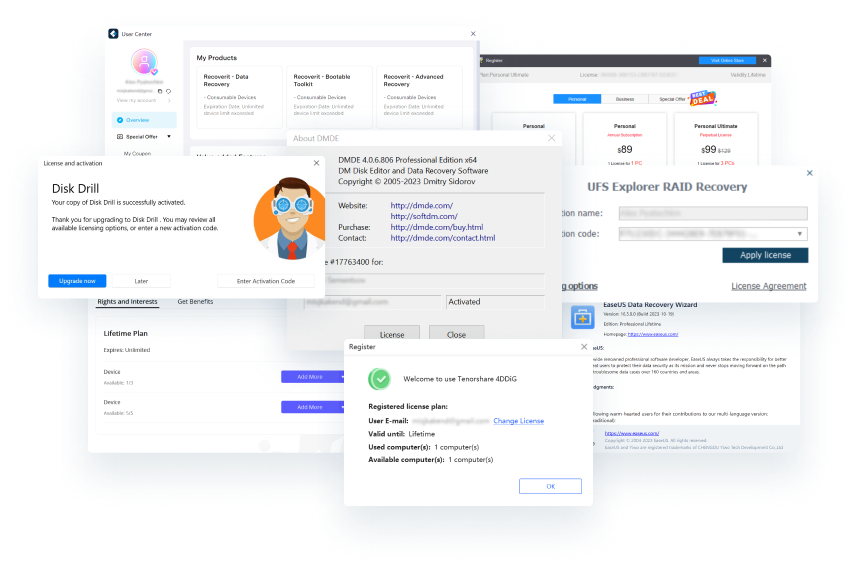How we test
At 7datarecovery.com, we pride ourselves on being a trusted source of information for everything related to data recovery. Our data-driven approach and strict, unbiased editorial standards guarantee an unmatched level of quality. We’ve been hard at work, and our database of reviews will only continue to grow.
-
14Reviews written
-
79Tools tested
-
14Devices used
Why Trust Us
We invest in the premium version of every data recovery tool we test. This guarantees that we can explore everything it has to offer, right down to the last detail. In doing so, we can give our readers a comprehensive, well-rounded evaluation of the tool so they can make an informed decision that’s backed by data.

Who Manages Our Tests
Our incredible technical team of data recovery specialists handles all of our testing. Our technical team takes a hands-on approach, actively testing the tools we cover by evaluating them using a strict, standardized review process that breaks down every aspect of the software into quantifiable data points. A standardized process allows us to evaluate each tool fairly and provide accurate comparisons. The data is then passed along to our editorial team, where one of our writers breaks down the information into an expertly crafted review that’s easy to read.

By having real-life data recovery experts run the tests directly, we can guarantee a level of quality that can’t be found anywhere else on the net. Not only does this help us remain a credible source of information, but it assures our readers that we know what we’re talking about. Learn more about our team behind the tests.
Our Testing Process
We have full confidence in the content we produce due largely in part to our rigorous, multi-step testing process. To best understand how we evaluate each tool, we’ll explain what we do at each step.
-
Step 1First, we create a pool of data recovery tools that are suitable for our case, sourcing them from various platforms such as the web, forums, and social media. We then narrow down the list and identify the tools that’re best suited for an in-depth review.
-
Step 2Once a tool has been selected, we create data recovery scenarios for the device we’re testing it on. By replicating common data loss scenarios, we can see how well the tool stands up in real-world situations. For example, for SD cards we simulate simple file deletion, formatting, and intentional file system corruption.
-
Step 3We have some basic parameters that are applied to each data recovery test. In addition to these parameters, we also hand-pick some that we believe are relevant to the specific tool we’ve selected. By clearly outlining the parameters guiding our review, we can provide our readers with a transparent understanding of what areas we prioritized.
-
Step 4This is where the testing phase begins. Our recovery expert takes a magnifying glass to the tool and picks apart its main characteristics and specifics. It’s at this stage where we simulate the loss of large datasets to see how well the tool recovers each file type. The tests are performed on multiple devices to eliminate the possibility of anomalies, further solidifying the results.
-
Step 5With all of the data collected, we begin rating the tool. We mostly evaluate the tool based on our own opinions and experiences, though we do consider reviews on social media and forums, so long as we don’t suspect they’ve been manipulated. After taking into account how the tool performed in all areas of assessment, it’s then assigned a final score that reflects its overall performance.
What Parameters We Look At
While the specific criteria we use differ based on the topic, there are several parameters that we pay close attention to when evaluating a software tool. These parameters were chosen based on what we believe contributes to an all-round good user experience.
Why Some Companies Don’t Make the Cut
Although we strive to review as many recovery tools available on the market, there are some that we choose not to review for one or several reasons. We may choose not to review software from a particular company for one of the following reasons.
Updates
We regularly review the relevance of our content and update it when we feel the information is no longer up-to-date. If a software update is released for a tool that we have reviewed, we will evaluate the new version and update our review accordingly
We never alter our rating upon the request of the participants. However, we do accept suggestions from our community (although the eventual rating will depend on the test results). If you have a suggestion for one of our content pieces, please contact us at help@7datarecovery.com and share your thoughts.





